Area of Parallelogram and Triangles Class 9 Ncert Solutions 9.3
NCERT Solutions class 9 maths exercise 9.3 of chapter 9-Areas of parallelogram and triangles

NCERT Solutions class 9 maths exercise 9.3 of chapter 9-Areas of parallelogram and triangles are created here for the purpose of helping the students of 9 class students to boost their preparation of exams. All questions of class 9 maths exercise 9.3 of chapter 9-Areas of parallelogram and triangles are solved by an expert of maths by a step by step method. Here you can study NCERT solutions of maths and science from class 9 to 12, sample papers, solutions of previous years' question papers. carrier oriented articles.
NCERT Solutions class 9 maths of chapter 9-Areas of parallelogram and triangles
Exercise 9.1 and 9.2- Areas of Parallelogram and Triangles
Exercise 9.3-Areas of Parallelogram and Triangles
Download pdf of NCERT solutions of class 9 maths chapter 9-Areas of Parallelogram and Triangle
PDF-NCERT solutions of class 9 maths chapter 9-Areas of Parallelogram
You can also study NCERT Solutions
Chapter 1-Number system
Chapter 2- Polynomial
Exercise 4.3- Linear equations in two variables
Exercise 4.1 & 4.2- Linear equation in two variables
Exercise 6.1-Lines and Angles
Exercise 6.2-Lines and Angles
Exercise 6.3-Lines and angles
Exercise 7.1- Triangles
Exercise 7.2- Triangle
Exercise 7.3-Triangle
Exercise 7.4-Triangle
Exercise.9.3- Areas of parallelograms and triangles
NCERT Solutions of Class 9 Science : Chapter 1 to Chapter 15
NCERT Solutions class 9 maths exercise 9.3 of chapter 9-Areas of parallelogram and triangles
Q1.In the given figure,E is any point on the median AD of a ΔABC .Show that ar(ABE) = ar(ACE).
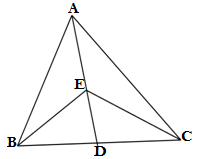
Ans. The median of triagle divides the triangle in two equal parts
AD is given us the median of ΔABC
∴ar ΔABD = arΔACD……(i)
ED is the median of ΔCBE
∴arΔDBE =arDCE……..(ii)
Subtracting equation (ii) from (i)
ar ΔABD – arΔDBE = arΔACD -arDCE
ar(ABE) = ar(ACE), Hence proved
Q2. In a triangle ABC, E is the midpoint of median AD .Show that ar(ΔBED) =1/4 ar(ΔABC).
Ans.
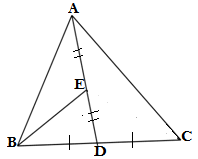
GIVEN: A ΔABC, AD is the median and E is the midpoint of AD
TO PROVE:ar(ΔBED) =1/4 ar(ΔABC)
PROOF: AD is the median of ΔABC (given)
∴ ar(ΔABD) = ar(ΔACD)
⇒ar(ΔABD) =1/2 ar((ΔABC)….(i)
AE = DE (E is the mid point of AD)
∴BE will be the median of ΔABD
ar(BED) = 1/2 ar (ABD)…..(ii)
From equation (i) and equation (ii)
ar(BED) = 1/2 × 1/2 ar((ΔABC)
ar(BED) = 1/4 ar((ΔABC),Hence proved
Q3.Show that diagonal of a parallelogram divide it into four triangles of equal area.
Ans.
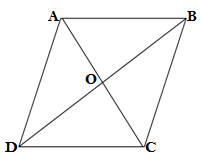
GIVEN: ABCD is a parallelogram and AC and BC are diagonals
TO PROVE: ar(AOB) = ar(AOD) =ar(DOC) =ar(BOC)
PROOF: In ΔADB
DO = BO (diagonal of parallelogram bisect each other)
∴ AO is the median of ΔADB
since the median of the triangle divides the triangle into two equal parts
∴ ar(AOD) = ar(AOB)
DO is the median of ΔADC
∴ar(AOD) =ar(DOC)
BO is the median of ΔABC
∴ar(AOB) =ar(BOC)
It is clear that
ar(AOB) = ar(AOD) =ar(DOC) =ar(BOC),Hence proved
Q4. In the given figure ,ABC and ABD are two triangles on the same base AB .If line segment CD is bisected by AB at O ,show that ar(ABC) = ar(ABD)
Ans.
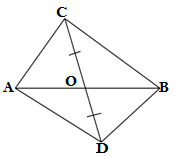
GIVEN: In ABCD ,CD is bisected by AB
CO = DO
TO PROVE: ar(ABC) = ar(ABD)
PROOF: CO = DO (given)
Therefore AO is the median of ΔADC and BO is the median of ΔBDC.
since the median of the triangle divides the triangle into two equal parts
∴ar(AOC)=ar(AOD)…(i)
ar(BOC) = ar(BOD)….(ii)
Adding both equations (i) and (ii)
ar(AOC)+ ar(BOC) =ar(AOD) + ar(BOD)
ar(ABC) = ar(ABD),Hence proved
Latest electronic items,mobiles,laptops and desktops at easy instalments
Q5. D,E and F are the mid points of the sides BC ,CA and AB of a ΔABC. Show that
(i) BDEF is a parallelogram
(ii) ar(DEF) = 1/4 ar(ABC)
(iii) ar(BDEF) = 1/2ar(ABC)
Ans.
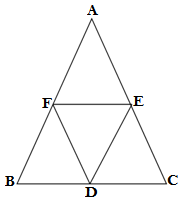
GIVEN:D,E and F are the mid points of the sides BC ,CA and AB of a ΔABC
TO PROVE:
(i) BDEF is a parallelogram
(ii) ar(DEF) = 1/4 ar(ABC)
(iii) ar(BDEF) = 1/2ar(ABC)
PROOF: (i) F is the midpoint of AB and E is the mid point of AC
According to mid point theorem
FE∥BC, FE = 1/2(BC)
⇒FE∥BD….(i)
D is the midpoint of BC and E is the mid point of AC
According to the midpoint theorem
DE∥AB, DE = 1/2(AB)
DE∥BF…..(ii)
Equation (i) and equation (ii) shows that
BDEF is a parallelogram
(ii) BDEF is a parallelogram
ar(DEF) = ar(BDF)…..(i)
DFAE and DFAC will also be parallelograms
ar(DEF) = ar(AFE)….(ii)
ar(DEF) = ar(DEC)….(iii)
From the figure we have
ar(DEF) + ar(AFE) + ar(DEC) +ar(BDF) = ar(ABC)
From (i),(ii) and (iii) we have
ar(DEF) +ar(DEF)+ar(DEF)+ar(DEF) = ar(ABC)
4 ar(DEF) = ar(ABC)
ar(DEF) = 1/4(ABC), Hence proved
(iii) ar(BDEF) = 1/2ar(ABC)
ar(DEF) = 1/4 ar(ABC) [Proved above]
4ar(DEF) = ar(ABC)
2 ar(DEF) + 2(DEF) = ar(ABC)
ar(BDEF) + ar(BDEF) = ar(ABC)
2ar(BDEF) = ar(ABC)
ar(BDEF) = 1/2(arABC),Hence proved
Please follow us on pintrest
Pintrest future study point
Q6. In the given figure ,diagonal AC and BD of quadrilateral ABCD intersect at O such that OB = OD, if AB = CD,then show that
(i) ar(DOC) = ar(AOB)
(ii) ar(DCB) = ar(ACB)
(iii) DA ∥ CB or ABCD is a parallelogram
[ Hint: from D and B , draw perpendiculars to AC]
Ans.

GIVEN: Diagonal AC and BD of quadrilateral ABCD intersect at O such that OB = OD
AB = CD
CONSTRUCTION: Drawing DE ⊥ AC, BF ⊥ AC
TO PROVE:
(i) ar(DOC) = ar(AOB)
(ii) ar(DCB) = ar(ACB)
(iii) DA ∥ CB or ABCD is a parallelogram
PROOF: In ΔDOE and ΔBOF
∠DOE = ∠BOF (vertically opposite angles)
∠DEO = ∠BFO =90°(DE ⊥ AC, BF ⊥ AC)
DO = BO (given)
ΔDOE ≅ ΔBOF (AAS rule)
ar(ΔDOE) = ar(ΔBOF)…..(i)
DE = BF (by CPCT)
In ΔDCE and ΔBFA
DE = BF (proved above)
AB = CD(given)
∠DEC = ∠BFA = 90°(DE ⊥ AC, BF ⊥ AC)
ΔDEC≅ ΔBFA(RHS rule)
ar(ΔDEC) = ar(ΔBFA)….(ii)
Adding equation (i) and (ii)
ar(ΔDOE)+ ar(ΔDEC) = ar(ΔBFA). + ar(ΔBOF)
ar(DOC) = ar(AOB),Hence proved
(ii) ar(DOC) = ar(AOB) [Proved above]
Adding ar(BOC) in both sides
ar(DOC)+ ar(BOC) = ar(AOB) + ar(BOC)
ar(DCB) = ar(ACB)
Q7.D and E are points on sides AB and AC respectively of ΔABC such that ar(DBC) = ar(EBC).Prove that DE||BC.
Ans.

GIVEN: D and E are points on sides AB and AC respectively of ΔABC such that ar(DBC) = ar(EBC)
TO PROVE:DE||BC
PROOF: We know the area of two triangles on the base and between the same parallels are equal,so its converse must also be true
Since ΔDBC and ΔEBC are on the same base BC and between the lines BC and DE
Therefore DE||BC,Hence proved
Q8.XY is a line parallel to side BC of a triangle ABC. If BE||AC and CF||AB meet XY at E and F respectively. show that ar(ABE) = ar(ACF)
Ans.

GIVEN: In figure, XY|| BC,BE||AC and CF||AB
TO PROVE: ar(ABE) = ar(ACF)
PROOF: BE||AC (given)
⇒ BE||YC…..(i)
CF||AB (given)
⇒BX ||AB ….(ii)
XY|| BC (given)
XY is extended upto E and F
⇒EY|| BC….(iii) and XF|| BC …(iv)
From (i) and (ii) it is clear that EYCB is a parallelogram
The parallelogram EYCB and triangle ABE are on the same base BE and between the same parallels BE||AC
ar(ΔABE) = 1/2(ar EYCB)…..(v)
From (ii) and (iii) it is clear that XFCB is a parallelogram
The parallelogram XFCB and triangle ACF are on the same base CF and between the same parallels BE||AC
ar(ΔACF) = 1/2(ar XFCB)…..(vi)
Since parallelogram EYCB and XFCB are on the same base BC and between the same parallels XF|| BC
ar(EYCB) = ar(XFCB)
From (vi),ar(ΔACF) = 1/2(ar EYCB)….(vii)
From (v) and (vii) ,we have
ar(ABE) = ar(ACF) ,Hence Proved
Q9.The side AB of a parallelogram ABCD is produced to any point P.A line through A and parallel to CP meets CB produced at Q and then parallelogram PBQR is completed (see the following figure). Show that ar(ABCD) = ar(PBQR)
[Hint: Join AC and PQ. Now compare area(ACQ) ad area(APQ)]

Ans.
GIVEN: ABCD is a parallelogram and AQ||CP ,PBQR is a parallelogram
TO PROVE: ar(ABCD) = ar(PBQR)
CONSTRUCTION: Joining A to C and P to Q
PROOF: The ΔACQ and ΔAPQ are on the same base AQ and between the same parallels AQ||CP
Therefore
ar ΔACQ = ΔAPQ …..(i)
ABC is the common figure in both the triangles ΔACQ and ΔAPQ
Subtracting arABC from both sides of equation (i)
ar ΔACQ – arABC = ΔAPQ- arABC
arΔABC = ar ΔPBQ
Since AC and PQ are the diagonals of parallelograms ABCD and PBQR
Therefore
2arΔABC = 2ar ΔPBQ (diagonals of parallelogram bisects it into two equal parts)
ar(ABCD) = ar(PBQR), Hence Proved
NCERT Solutions of Science and Maths for Class 9,10,11 and 12
NCERT Solutions of class 9 maths
| Chapter 1- Number System | Chapter 9-Areas of parallelogram and triangles |
| Chapter 2-Polynomial | Chapter 10-Circles |
| Chapter 3- Coordinate Geometry | Chapter 11-Construction |
| Chapter 4- Linear equations in two variables | Chapter 12-Heron's Formula |
| Chapter 5- Introduction to Euclid's Geometry | Chapter 13-Surface Areas and Volumes |
| Chapter 6-Lines and Angles | Chapter 14-Statistics |
| Chapter 7-Triangles | Chapter 15-Probability |
| Chapter 8- Quadrilateral |
NCERT Solutions of class 9 science
| Chapter 1-Matter in our surroundings | Chapter 9- Force and laws of motion |
| Chapter 2-Is matter around us pure? | Chapter 10- Gravitation |
| Chapter3- Atoms and Molecules | Chapter 11- Work and Energy |
| Chapter 4-Structure of the Atom | Chapter 12- Sound |
| Chapter 5-Fundamental unit of life | Chapter 13-Why do we fall ill ? |
| Chapter 6- Tissues | Chapter 14- Natural Resources |
| Chapter 7- Diversity in living organism | Chapter 15-Improvement in food resources |
| Chapter 8- Motion | Last years question papers & sample papers |
CBSE Class 9-Question paper of science 2020 with solutions
CBSE Class 9-Sample paper of science
CBSE Class 9-Unsolved question paper of science 2019
NCERT Solutions of class 10 maths
| Chapter 1-Real number | Chapter 9-Some application of Trigonometry |
| Chapter 2-Polynomial | Chapter 10-Circles |
| Chapter 3-Linear equations | Chapter 11- Construction |
| Chapter 4- Quadratic equations | Chapter 12-Area related to circle |
| Chapter 5-Arithmetic Progression | Chapter 13-Surface areas and Volume |
| Chapter 6-Triangle | Chapter 14-Statistics |
| Chapter 7- Co-ordinate geometry | Chapter 15-Probability |
| Chapter 8-Trigonometry |
CBSE Class 10-Question paper of maths 2021 with solutions
CBSE Class 10-Half yearly question paper of maths 2020 with solutions
CBSE Class 10 -Question paper of maths 2020 with solutions
CBSE Class 10-Question paper of maths 2019 with solutions
NCERT solutions of class 10 science
| Chapter 1- Chemical reactions and equations | Chapter 9- Heredity and Evolution |
| Chapter 2- Acid, Base and Salt | Chapter 10- Light reflection and refraction |
| Chapter 3- Metals and Non-Metals | Chapter 11- Human eye and colorful world |
| Chapter 4- Carbon and its Compounds | Chapter 12- Electricity |
| Chapter 5-Periodic classification of elements | Chapter 13-Magnetic effect of electric current |
| Chapter 6- Life Process | Chapter 14-Sources of Energy |
| Chapter 7-Control and Coordination | Chapter 15-Environment |
| Chapter 8- How do organisms reproduce? | Chapter 16-Management of Natural Resources |
Solutions of class 10 last years Science question papers
CBSE Class 10 – Question paper of science 2020 with solutions
CBSE class 10 -Latest sample paper of science
NCERT solutions of class 11 maths
| Chapter 1-Sets | Chapter 9-Sequences and Series |
| Chapter 2- Relations and functions | Chapter 10- Straight Lines |
| Chapter 3- Trigonometry | Chapter 11-Conic Sections |
| Chapter 4-Principle of mathematical induction | Chapter 12-Introduction to three Dimensional Geometry |
| Chapter 5-Complex numbers | Chapter 13- Limits and Derivatives |
| Chapter 6- Linear Inequalities | Chapter 14-Mathematical Reasoning |
| Chapter 7- Permutations and Combinations | Chapter 15- Statistics |
| Chapter 8- Binomial Theorem | Chapter 16- Probability |
CBSE Class 11-Question paper of maths 2015
CBSE Class 11 – Second unit test of maths 2021 with solutions
NCERT solutions of class 12 maths
| Chapter 1-Relations and Functions | Chapter 9-Differential Equations |
| Chapter 2-Inverse Trigonometric Functions | Chapter 10-Vector Algebra |
| Chapter 3-Matrices | Chapter 11 – Three Dimensional Geometry |
| Chapter 4-Determinants | Chapter 12-Linear Programming |
| Chapter 5- Continuity and Differentiability | Chapter 13-Probability |
| Chapter 6- Application of Derivation | CBSE Class 12- Question paper of maths 2021 with solutions |
| Chapter 7- Integrals | |
| Chapter 8-Application of Integrals |
How to creat and solve algebraic equations like linear and quadratic equations
Achieve hundred percentage marks in maths
NCERT Maths Specific Questions Of Mensuration Class IX & X
Study science notes
Archimedes Principle: Complete detail
Average Speed and Average velocity
Three equation of Motions
Recoil velocity of the gun
Mole concept
The second law of motion
The universal law of gravitational force
Thrust and Pressure : Difference
You can compensate us by donating any amount of money for our survival
Our Paytm NO 9891436286
Area of Parallelogram and Triangles Class 9 Ncert Solutions 9.3
Source: https://futurestudypoint.com/ncert-solutions-class-9-maths-exercise-9-3-of-chapter-9-areas-of-parallelogram-and-triangles/
0 Response to "Area of Parallelogram and Triangles Class 9 Ncert Solutions 9.3"
Post a Comment